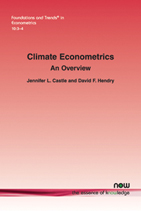Climate Econometrics: An Overview
By Jennifer L. Castle, University of Oxford, UK, jennifer.castle@magd.ox.ac.uk | David F. Hendry, University of Oxford, UK, david.hendry@nuffield.ox.ac.uk
Abstract
Climate econometrics is a new sub-discipline that has grown rapidly over the last few years. As greenhouse gas emissions like carbon dioxide (CO2), nitrous oxide (N2O) and methane (CH4) are a major cause of climate change, and are generated by human activity, it is not surprising that the tool set designed to empirically investigate economic outcomes should be applicable to studying many empirical aspects of climate change.
Economic and climate time series exhibit many commonalities. Both data are subject to non-stationarities in the form of evolving stochastic trends and sudden distributional shifts. Consequently, the well-developed machinery for modeling economic time series can be fruitfully applied to climate data. In both disciplines, we have imperfect and incomplete knowledge of the processes actually generating the data. As we don’t know that data generating process (DGP), we must search for what we hope is a close approximation to it. The data modeling approach adopted at Climate Econometrics (http://www.climateeconometrics.org/) is based on a model selection methodology that has excellent properties for locating an unknown DGP nested within a large set of possible explanations, including dynamics, outliers, shifts, and non-linearities. The software we use is a variant of machine learning which implements multi-path block searches commencing from very general specifications to discover a well-specified and undominated model of the processes under analysis. To do so requires implementing indicator saturation estimators designed to match the problem faced, such as impulse indicators for outliers, step indicators for location shifts, trend indicators for trend breaks, multiplicative indicators for parameter changes, and indicators specifically designed for more complex phenomena that have a common reaction ‘shape’ like the impacts of volcanic eruptions on temperature reconstructions. We also use combinations of these, inevitably entailing settings with more candidate variables than observations.
Having described these econometric tools, we take a brief excursion into climate science to provide the background to the later applications. By noting the Earth’s available atmosphere and water resources, we establish that humanity really can alter the climate, and is doing so in myriad ways. Then we relate past climate changes to the ‘great extinctions’ seen in the geological record. Following the Industrial Revolution in the mid-18th century, building on earlier advances in scientific, technological and medical knowledge, real income levels per capita have risen dramatically globally, many killer diseases have been tamed, and human longevity has approximately doubled. However, such beneficial developments have led to a global explosion in anthropogenic emissions of greenhouse gases. These are also subject to many relatively sudden shifts from major wars, crises, resource discoveries, technology and policy interventions. Consequently, stochastic trends, large shifts and numerous outliers must all be handled in practice to develop viable empirical models of climate phenomena. Additional advantages of our econometric methods for doing so are detecting the impacts of important policy interventions as well as improved forecasts. The econometric approach we outline can handle all these jointly, which is essential to accurately characterize non-stationary observational data. Few approaches in either climate or economic modeling consider all such effects jointly, but a failure to do so leads to mis-specified models and hence incorrect theory evaluation and policy analyses. We discuss the hazards of modeling wide-sense non-stationary data (namely data not just with stochastic trends but also distributional shifts), which also serves to describe our notation.
The application of the methods is illustrated by two detailed modeling exercises. The first investigates the causal role of CO2 in Ice Ages, where a simultaneous-equations system is developed to characterize land ice volume, temperature and atmospheric CO2 levels as non-linear functions of measures of the Earth’s orbital path round the Sun. The second turns to analyze the United Kingdom’s highly non-stationary annual CO2 emissions over the last 150 years, walking through all the key modeling stages. As the first country into the Industrial Revolution, the UK is one of the first countries out, with per capita annual CO2 emissions now below 1860’s levels when our data series begin, a reduction achieved with little aggregate cost. However, very large decreases in all greenhouse gas emissions are still required to meet the UK’s 2050 target set by its Climate Change Act in 2008 of an 80% reduction from 1970 levels, since reduced to a net zero target by that date, as required globally to stabilize temperatures. The rapidly decreasing costs of renewable energy technologies offer hope of further rapid emission reductions in that area, illustrated by a dynamic scenario analysis.
Climate Econometrics: An Overview
Climate Econometrics: An Overview provides a review of the research in this new and growing field. The structure of the monograph is as follows: First, section 2 describes econometric methods for empirical climate modeling that can account for wide-sense non-stationarity, namely both stochastic trends and location shifts, with possibly large outliers, as well as dynamics and non-linearities. Section 3 considers hazards confronting empirical modeling of nonstationary time-series data using an example where a counter-intuitive finding is hard to resolve. The framework has a clear subject-matter theory, so is not mere ‘data mining’, yet the empirical result flatly contradicts the well-based theory. Section 4 provides a brief excursion into climate science, mainly concerned with the composition of the Earth’s atmosphere and the role of CO2 as a greenhouse gas. Section 5 considers the consequences, both good and bad, of the Industrial Revolution raising living standards beyond the wildest dreams of those living in the 17th century, but leading to dangerous levels of CO2 emissions from using fossil fuels and consider applications of climate econometrics against that background. Section 6 illustrates the approach by modeling past climate variability over the Ice Ages. Section 7 models UK annual CO2 emissions over 1860–2017 to walk through the stages of modeling empirical time series that manifest all the problems of wide-sense non-stationarity. Section 8 concludes and summarizes a number of other empirical applications.
